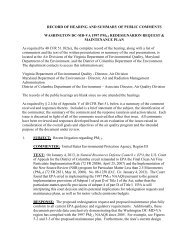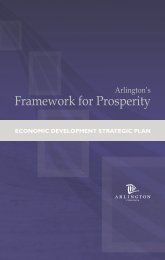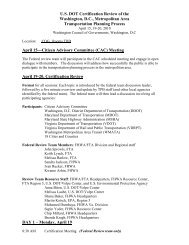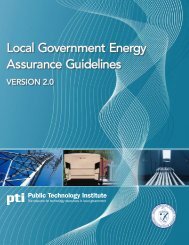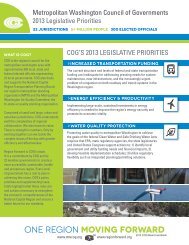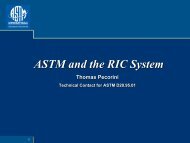Calibration Report for the TPB Travel Forecasting Model, Version ...
Calibration Report for the TPB Travel Forecasting Model, Version ...
Calibration Report for the TPB Travel Forecasting Model, Version ...
Create successful ePaper yourself
Turn your PDF publications into a flip-book with our unique Google optimized e-Paper software.
<strong>Calibration</strong> <strong>Report</strong> <strong>for</strong> <strong>the</strong> <strong>TPB</strong> <strong>Travel</strong> <strong>Forecasting</strong> <strong>Model</strong>, <strong>Version</strong> 2.3<br />
Table 43 Regional Estimated and Observed Trip lengths and Intra‐zonal Percentages .......................................... 5‐10<br />
Table 44 Differences between <strong>the</strong> <strong>Version</strong> 2.2 and <strong>Version</strong> 2.3 mode choice models ............................................. 6‐2<br />
Table 45 Comparison of characteristics found in both <strong>the</strong> AECOM/WMATA NLMC model and <strong>the</strong> <strong>TPB</strong> NLMC<br />
model ...................................................................................................................................................... 6‐6<br />
Table 46 Household income quartiles computed from <strong>the</strong> ACS ................................................................................ 6‐7<br />
Table 47 Equivalency between nested‐logit mode choice superdistricts and <strong>TPB</strong> TAZ 3,722 ................................... 6‐8<br />
Table 48 Production and attraction market segments used in <strong>the</strong> <strong>TPB</strong> <strong>Version</strong> 2.3 NLMC model ........................... 6‐9<br />
Table 49 20 geographic market segments used in <strong>the</strong> <strong>TPB</strong> nested‐logit mode choice model ................................. 6‐9<br />
Table 50 Equivalency between seven super‐districts and <strong>the</strong> 20 geographic market segments ............................ 6‐10<br />
Table 51 Time and cost coefficients in <strong>the</strong> <strong>Version</strong> 2.3 nested‐logit mode choice model ...................................... 6‐13<br />
Table 52 Income constants used in <strong>the</strong> <strong>TPB</strong> Ver. 2.3 NLMC model ......................................................................... 6‐15<br />
Table 53 Interpretation of nesting coefficient values in nested‐logit mode choice models ................................... 6‐16<br />
Table 54 Transit person trip control totals (“targets”) <strong>for</strong> 2007, average weekday ................................................ 6‐20<br />
Table 55 Year‐2007 auto targets from a simulated trip table: Be<strong>for</strong>e updating HOV trips .................................... 6‐21<br />
Table 56 Year‐2007 auto targets from a simulated trip table: After updating HOV trips ....................................... 6‐21<br />
Table 57 Year‐2007 auto targets from a simulated trip table: Difference .............................................................. 6‐21<br />
Table 58 Transit surveys used to calculate transit trip targets ................................................................................ 6‐22<br />
Table 59 Top‐level equivalent nesting constants <strong>for</strong> HBW ...................................................................................... 6‐23<br />
Table 60 Top‐level equivalent nesting constants <strong>for</strong> HBS ....................................................................................... 6‐23<br />
Table 61 Top‐level equivalent nesting constants <strong>for</strong> HBO ....................................................................................... 6‐24<br />
Table 62 Top‐level equivalent nesting constants <strong>for</strong> NHW ..................................................................................... 6‐24<br />
Table 63 Top‐level equivalent nesting constants <strong>for</strong> NHO ...................................................................................... 6‐25<br />
Table 64 Person trips summarized by travel mode and trip purpose, summed <strong>for</strong> all 20 geographic market<br />
segments ............................................................................................................................................... 6‐28<br />
Table 65 Total person trips summarized by market segment ................................................................................. 6‐29<br />
Table 66 Transit person trips summarized by market segment .............................................................................. 6‐29<br />
Table 67 Transit person trips summarized by transit submode .............................................................................. 6‐30<br />
Table 68 Transit person trips summarized by access mode to transit .................................................................... 6‐30<br />
Table 69 <strong>Version</strong> 2.3 Temporal Factors (Percentages) For Truck and Non‐<strong>Model</strong>ed <strong>Travel</strong> Markets ....................... 7‐2<br />
Table 70 Initial, Household <strong>Travel</strong> Survey‐based temporal travel distributions by purpose, mode, and direction .. 7‐3<br />
Table 71 Final temporal travel distributions by purpose, mode, and direction ........................................................ 7‐4<br />
Table 72 A comparison of traffic assignment features in <strong>the</strong> <strong>Version</strong> 2.2 and 2.3 travel models ............................. 8‐1<br />
Table 73 Specs of travel model server tms3 .............................................................................................................. 8‐2<br />
Table 74 Conical volume‐delay functions used in <strong>the</strong> <strong>Version</strong> 2.3 travel model: Tabular <strong>for</strong>mat ........................... 8‐15<br />
Table 75 Free Flow Capacities ................................................................................................................................. 8‐17<br />
Table 76 Free Flow Speeds ...................................................................................................................................... 8‐18<br />
Table 77 Peak‐ Hour Percentage by Time Period based on Total Auto Driver Trips in Motion Distribution ........... 8‐18<br />
Table 78 2007 Estimated/Observed (HPMS) VMT <strong>for</strong> <strong>the</strong> Washington, DC MSA (in thousands) .............................. 9‐2<br />
Table 79 Year 2007 Estimated and Observed VMT Summary by Jurisdiction (in thousands) ................................... 9‐2<br />
Table 80 Year 2007 Estimated and Observed Daily Screenline Crossings ................................................................. 9‐5<br />
Table 81 Percent RMSE by Facility Type .................................................................................................................... 9‐6<br />
Table 82 Estimated and Observed 2007/2008 HBW Metrorail Productions & Attractions by Station Group .......... 9‐6<br />
Table 83 Estimated and Observed 2007/2008 Total Metrorail Productions & Attractions by Station Group .......... 9‐7<br />
Table 84 Comparison of 2007 Estimated and Observed Trips by Purpose and Mode .............................................. 9‐9<br />
Table 85 Summary of <strong>Version</strong> 2.2 and <strong>Version</strong> 2.3 travel model output: Years 2005, 2007 and 2011 ................... 9‐10<br />
Table 1 Jurisdictional Production Adjustment Factors (“P‐mods”) ........................................................................... A‐1<br />
vi



